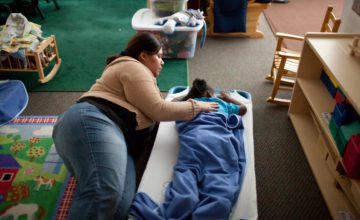Sharla Green Kibel and Amanda Rojas Hernandez, County of Santa Clara Behavioral Health Services Department San Jose, California

Abstract
The use of the multiaxial dimensions of the DC:0–5 classification system during the assessment process provides an organizing framework for understanding the impact of family relationships on a child’s functioning. In this article, the authors describe an assessment with a high-conflict family and how contrasting the impact of parental conflict with the strengths of each parent provided deeper insight into the child’s and family’s needs and opportunities. The authors highlight the interplay between reflective inquiry during an assessment, and the role of assessment in the earliest steps of intervention.
This article is focused on how the dimensions of the DC:0–5TM: Diagnostic Classification of Mental Health and Developmental Disorders of Infancy and Early Childhood (DC:0–5; ZERO TO THREE, 2016) organized our thinking and practice during the assessment process for 3-year-old Jorge and his parents as they navigated the difficulties of parental separation and shared custody in the face of painful mutual distrust. (This case represents a composite of client experiences, therefore personal health information is de-identified.) A diagnostic process asks us to gather and organize information, and the multiaxial structure of DC:0–5 demands of us a relational and reflective capability—especially when considering the relative impact of the relational context/Axis II. We will each share our own thoughts and experiences as we describe the consultative process. Amanda, an infant and early childhood mental health specialist, is a therapist providing assessment through a county behavioral health clinic. Sharla’s role, as a reflective consultant, was to support Amanda (and indirectly the parents) to tolerate the ambiguity of waiting to understand what may not be ready to be named or defined while the assessment process unfolds.
An Anxious Family
“Hi, I just got your contact information today at family court. I need you to call me back, and schedule an appointment with me before you talk to my child’s mother. You need to know my concerns,” said Jorge’s father, Juan, on my voice mailbox.
Amanda: I felt the tone of urgency in his voice, and I began to wonder what would unfold during this assessment process. Jorge had been referred to services by his mother without his father being informed. As the birth-5 assessor who would only be completing the child’s assessment, determining eligibility for services, and next steps, there was a sense of wanting to make sure I was going to capture the full experience Jorge was having.
Jorge was a 3-year-old Latinx and Caucasian bilingual (English/ Spanish) male whose parents, June and Juan, shared 50/50 custody. He had to cycle frequently between parents every 2 days or so. Jorge’s parents had been separated since he was 2 years old, due to having caused each other mutual unhappiness and there had been ongoing challenges in co-parenting. Jorge was described as having episodes of emotional meltdowns to and from pick-ups lasting for about 30 minutes at every exchange. Jorge displayed distress when anticipating transitions between parents and during transitions. His mother had observed anxious restlessness and his father had observed him be more easily frustrated and less responsive to father’s requests. In addition, his functioning in preschool with regard to peer relationships was emerging as a concern. During the assessment period, preschool concerns also became more acute as described below.
June, Jorge’s mother (42), was a Caucasian woman with a history of incarceration for past substance use issues and of perinatal mental health challenges. She had experienced hyperemesis gravidarum (persistent nausea) with associated depression during and after her pregnancy. This perinatal condition had also led to some relapse in the use of psychotropic substances. In contrast to Jorge’s father, Juan, June is financially comfortable due to family support. Her main concern was her son’s emotional well-being as he had experienced so many changes in his lifetime, and she felt that as a result he was having a very upsetting time.
June was the parent who signaled that Jorge needed help. Since Juan’s housing instability began, she had noticed an increase in her son’s worrying, nail biting, fidgeting, and selective responses to instructions. Juan had a different understanding of Jorge’s unhappiness. He was focused on Jorge’s repeated questions and anxiety about when the next move to his mom would occur. Juan shared that Jorge would often not listen to him, talking back at times. Jorge would try to control his dad by “fake” crying and appearing to tantrum when seeking his father’s attention. Juan felt these behaviors had begun 2 months’ earlier coinciding with when his housing became unstable due to arguments with the sister with whom he had been residing. Juan was vague about how he and Jorge found lodging at times since his sister asked him to leave. Sometimes Jorge stayed with his aunt, and sometimes he would accompany his father to a friend’s home. Eventually Juan was able to qualify for a housing unit. Jorge’s parents had simultaneously begun a new custody arrangement at this time. Previously, June had full custody while Juan had only weekend overnight visits. However, the new custody arrangement gave the parents 50/50 custody and Jorge cycled between them every few days.
Both parents reported that their child had witnessed arguments between them during exchanges, which resulted in Jorge’s crying and screaming. They expressed concern that he would witness the other parent “bad talk,” the other in the presence of their child. There were vivid descriptions of the arguments, which included name calling and shaming. Juan shared he was repeatedly called, “worthless and unstable.” Mother recalled that she would be verbally attacked at exchanges when a few minutes late. Each parent had felt verbally and emotionally abused by the other.
Evaluator Resonates With Child’s Pain and Parent’s Intensity (Amanda)
As a provider, I noticed right away each parent’s intention to have me be on their side. They each had presented their perspective and blamed the other for the impact it was having on their son. They frequently sought out validation from me and questioned my competence and credentials when validation was not given. I began to feel as if I were being triangulated—a position of their each trying to align me in a “two against one” dynamic. Each parent had their own agenda, which included making the other parent look bad. What I was experiencing in this triangle was the reality of what their son was enduring on a daily basis. The mother and father were not aware of how much their discord intensified their son’s stress over separations, how their demands for loyalty and taking sides placed undue pressure on Jorge, and the overall impact of parental conflict and family stress on his emotional well-being.
After the first session with each parent, there was a heaviness that came to me. As I heard the accusations and reports from each parent, I noticed the parallel grievances and how these were hurting their child. So many layers needed to be considered that I knew that guidance and support from our county early childhood mental health consultant, Sharla, was needed in order to determine the best next steps for this child and parents.
Consultation Begins (Sharla)
Amanda came to me to describe Jorge and his family, whose parents both had quite a lot of urgency for their concerns about Jorge and his transitions to be understood; and also, for their concerns about his difficulty with his other parent to be understood. These situations are sadly quite frequent in our practice where a child’s stress experience and the child’s absorbing of parental anxiety and sense of threat gets confused with the adult agendas and unfinished pain in adult relationships.
Amanda’s experience of this family included a great sense of pressure. It pointed me to consider more carefully the difference between each parent’s one-on-one relationship with the child and the child’s experience of the total relational context of being caught between two caregivers and each caregiver’s anxieties about the other parent. I sensed a parallel process, that Amanda was experiencing similar confusion and stress to that impacting Jorge.
Distrust fuels challenges in the child’s capacity to navigate differences between caregivers. Lack of trust is easily transferred to the clinician as well. Each parent wonders, “Can I trust that you are going to be able to hold the total picture and that you will also see through my lens?” As a reflective consultant, I found myself toggling my focus between the specificity of information being gathered and the fluidity of how attributions and interpretations were impacting everyone’s functioning.
The Organizing Opportunity Offered by DC:0–5
The DC:0–5 multiaxial framework provides a valuable path toward organizing one’s thinking about the multiple dimensions affecting Jorge and his parents. We consider each dimension or axis (physical health and conditions, psychosocial stressors, developmental competence, relational context, clinical disorders/impairments) independently and also with regard to how they interact with each other. The recommended sequence of axes (see Jargon Buster, p. 99) guides us into considering the less obvious components that influence functioning. Ideally, we engage in a meaningful and systematic diagnostic process that assists us in teasing out a child’s level of impairment from the relational context. Power differentials of gender, class, ethnicity, and oppression weave into these dynamics. We needed to understand Jorge’s capacities and difficulties across relationships and settings while also allowing for how his coping might fluctuate with shifting circumstances.
As we explored what symptoms the child could be experiencing and how they might be impairing, we noticed the challenge of pinning down Jorge’s functioning separate from the buffeting of parental anxieties and discord. While his anxiety levels fluctuated with his parents’ reactions, he also appeared to be having increasing difficulty with being soothed both before and after transitions. His ability to handle frustrations in preschool was deteriorating. We considered what else we would want to discover to better understand the whole configuration.
Assessment Inquiry as a Modulating Intervention
During assessment, inquiry became part of both assessment and preliminary intervention. The assessment provided a key opportunity to use curiosity as a modulating intervention for inviting each parent to tolerate more complexity in their understanding of Jorge’s experience. We wondered about the meaning of recent events to Jorge and about how each parent’s cultural experience might shed additional light on the flow of interactions and meaning making.
Opening a Larger Conversation (Amanda)
Both parents had reported that most recently, Jorge’s intense anxiety and avoidance were impacting his ability to form and maintain peer relationships at preschool and impacted his daily activities, in that they often had to miss out on opportunities or re-arrange their schedule/routine due to problematic occurrences at preschool. These new behaviors were causing unexpected disruptions and parents themselves were starting to notice how they were beginning to feel uncomfortable with not being able to manage their son’s problems. Each parent expressed urgency about solving the alternating avoidance and emotional outbursts in preschool.

Distrust fuels challenges in the child’s capacity to navigate differences between caregivers. Photo: shutterstock/aslysun
When I addressed the distrust and animosity between parents as key to Jorge’s distress, they initially denied the observations being presented. Each parent positioned themselves as the victim of the other parent. I continued to present my observations and posed open-ended questions, inquiring into the meaning of their child’s behaviors in their presence. They gradually became more able to acknowledge their own contributions to the distrust and discord in the family. June shared that her coping strategy was to withdraw and isolate which led to poor communication with Juan. He came to understand that his own history of family instability and mental health history had led to his limited capacity to be an emotionally supportive partner.
Parental Legacies
June shared that she experienced perinatal depression during her pregnancy and postpartum period, which she felt did have an impact on her attachment experience with Jorge. She constantly felt she needed to make up for this disruption as she sought to repair their relationship. June felt that, at times, she needed to overcompensate for time that she reported she lost, by giving in to her son’s demands or requests. She shared that during postpartum, she began to feel that she was not adequate to watch Jorge alone and she relied very much on Juan to take over most of the daily tasks of parenting— including feedings, diaper changes, and baths. It was hard for her to allow Jorge to tolerate reasonable frustration for a 3-year-old.

Each parent positioned themselves as the victim of the other parent. Photo: shutterstock/New Africa
Juan (32) is a first-generation Latinx male with a history of family discord, mental health challenges, and gender role conflict. He described rigid expectations in his traditional Latinx family regarding how one walks through the world as a man and a father. He had some mental health support as a teen but has a lot of ambivalence about seeking emotional or social support. Verbal altercations had resulted in his having to leave many of the locations where he and his son had stayed. Due to his own mental health challenges, he was able to provide very limited support for June when dealing with perinatal mental health. During this difficult time, challenges in communication increased and the parents began to feel as though the other parent did not trust each other’s parenting capacity. Juan commented that he was made to feel incompetent.
Observations
During the observation of the father–son dyad, Jorge and Juan enjoyed each other while completing a puzzle together. Jorge did engage in attention-seeking behaviors such as fake crying and stomping when father was doing his own activity. Jorge was also observed to test Juan’s limits when he asked him to transition. While interactions between Jorge and Juan were seen as functional for them, there were many moments of rupture and repair. Juan acknowledged all the changes that he and his son had endured in a short time and wanted his son to know that he was doing the best he could for them. This reflective moment gave me an opportunity to use Brazelton Touchpoints technique (Brazelton, 1994) of anticipatory guidance to normalize Jorge’s developmental times of regression followed by more integrated functioning.
The mother–son dyad interaction consisted of imaginative play with action figures. Jorge, with mother’s support, displayed problem-solving skills when one of his figures was not available and he used another object as a replacement. When June said it was time to transition to snack time, Jorge suggested more time for play and less for snack. June shared that Jorge recently was negotiating at every opportunity he had. She noticed how her son was developing his voice and wanted him to use it. He was giving more opinions about preferences and his likes and dislikes. June wanted the best for her son. Assessed strengths in June’s interactions with Jorge included effective use of language, physical proximity, and mirroring.
Growing Awareness of Child’s Distress (Amanda)
Through consistent validation, reflective listening, boundary setting, and empathy, I built rapport with each parent in the diagnostic assessment phase. For example, when June complained about Juan’s tone during one of their exchanges, I focused on how Jorge was doing, and how he would have interpreted the situation that had just unfolded. I had June reflect on how Jorge may have noticed her uncomfortable body language. Likewise, with Juan, I would listen to his experiences and redirect them back to Jorge’s perspective at that moment. These examples highlight a few of the multiple difficult interactions that Jorge has witnessed. It was through this process of rapport-building that each parent began to see how their actions were impacting their son. They started to recognize the confusing experience of Jorge having to witness each parent’s distrust toward the other. All the blaming and “bad-talking” each other, and hostility at their exchanges, was resulting in additional distress for their son. The unresolved pain in their own relationship was getting in the way of their child’s capacity to adjust to new conditions.
Utilizing the Axes of DC:0–5
DC:0–5 multiaxial framework worksheets were used to rate Axes III–V, highlighting other factors to consider as well as the cultural formulation. We begin with the contextual axes first, to aide in the differential diagnosis for Axis I.
Axes III–V, and Cultural Formulation
We follow the guidance from the DC:0–5 training curriculum of beginning with the contextual axes. In Axis III, the mother’s prenatal conditions of hyperemesis gravidarum (severe nausea and vomiting), perinatal depression, and exposures to psychotropic substances were noted.
Psychosocial stressors in Axis IV included parental separation, mental health of caregivers, pregnancy-related stressors, inadequate social support from paternal family, father’s unpredictable housing, father’s discrimination, father’s homelessness, multiple moves, global pandemic, child welfare involvement, and active custody dispute. The multiple stressors experienced by Jorge and his family expanded the understanding of Jorge’s adjustment challenges. When looking at the developmental competencies (Axis V) that Jorge possessed, Appendix A of the manual, along with the Ages and Stages Questionnaire (Squires & Bricker, 2009) screening tools and observations helped establish that he was typical in most developmental domains, but delayed in the emotional domain.
The information about Axis IV stressors is also intertwined with the cultural formulation. Juan is a first generation Latinx male, with a family history of mental health difficulties. His paternal family strictly follows and believes in gender roles and expectations. The stressors of inadequate paternal family support, father’s unpredictable housing, father’s experience of discrimination, and ultimately father’s homelessness all have roots in cultural oppression. Within his paternal family, there is stigma associated with emotional suffering, especially for males. To have a mental illness within the family is depicted as a deficiency in one’s “manhood,” and therefore the individual is often ostracized, which was what Juan was experiencing and which in turn impacted how Juan had difficulty thinking about Jorge’s suffering. Jorge, in turn, as a second generation Latinx male is at risk of being weighed down by these cultural gender expectations.
Sharla: Cultural influences, attributions, and interactions are all connected. As we considered the cultural formulation in the DC:0–5, we noticed how Juan had difficulty tolerating expressions of distress from his son. The cultural stigma around a male’s expressing emotion created pressure to blame Jorge’s mother rather than acknowledge his son’s vulnerability. Amanda and I had discussed how her own Latinx heritage afforded her empathy for Juan’s internalized gender expectations. It was also, however, challenging to manage his expectations that a Latinx woman would comply with his demands. June had similarly reported a history of difficulty negotiating Juan’s expectations of a female partner.
Amanda’s support to Juan to normalize Jorge’s uneven developmental trajectory helped him to notice what was unfolding in his own relationship with Jorge, rather than blaming typical developmental challenges on June’s influence. June’s family had worked hard to attain more financial security and this background fueled her tension about how Juan’s volatile housing situation might impact their son’s sense of stability.
Axis IIA and Axis IIB
Axis II rates the relational context in two parts. We first consider the level of adaptive functioning of the child’s relationship with each significant caregiver. A 4-point scale is used: Level 1—well-adapted to good enough, Level 2—strained to concerning, Level 3—compromised to disturbed, and Level 4—disordered to dangerous. The same level descriptions are used to describe the second part of Axis II which evaluates the child’s level of adaptive functioning in the caregiving environment. (See Figure 1.)
Figure 1. Axis II, Part B: Caregiving Environment and Infant/Young Child Adaptation
Adaptive functioning ratings on the caregiver–child relationship were completed for each parent–dyad, which each did reasonably well with these first ratings. Areas of relative strength for June were establishing structure and routine, engaging in play and enjoyable activities, and socializing. Juan’s strengths were engaging in play and enjoyable activities, teaching, and social stimulation. Both parents demonstrated reflective capacity regarding the child’s developmental trajectory as a mutual strength. There was more unevenness in their capacities to reflect on Jorge’s distress signals and to acknowledge ambivalent feelings toward their child. While we considered ratings of 3 (compromised to disturbed), Jorge displayed significant spontaneous pleasurable interaction within each child–parent relationship. Thus, each child–caregiver relationship received a rating of Level 2 (strained to concerning) in describing the level of adaptive functioning.
Amanda: When determining adaptive functioning ratings for the caregiving environment, I had to learn how to look beyond each parent’s contribution to how they functioned together within the web of relationships in order to determine the overall rating. While both wanted to plan well to meet Jorge’s needs, they had great difficulty coordinating or agreeing on decisions regarding their child. This occurred in many domains, from child care to medical care. I consulted with Sharla, given that each parent was still invested in Jorge’s well-being. She assisted me in understanding that for this portion, an integrated impression of the parents’ capacity to cooperate in caring for Jorge would yield a level of adaptation of the caregiving environment.

June shared that she experienced perinatal depression during her pregnancy and postpartum period, which she felt did have an impact on her attachment experience with Jorge. Photo: shutterstock/christinarosepix
Sharla: As I reviewed Amanda’s ratings, we discussed how crucial it was to understand the impact of these caregivers’ difficulties with “caregiving communication” and “behavioral regulation and coordination.” These are capacities listed in the manual (ZERO TO THREE, 2016, p. 146, Table 3) that guide ratings of adaptive functioning in the caregiving environment. The emotional investment of each parent was in their own perception of Jorge’s relative experience with each of them rather than investing in his having emotional permission to love them both. We agreed on a rating for the level of adaptive functioning for the child–caregiving environment relational context as a 3 (compromised to disturbed)
Axis I and the Power of Narrative
Many clinical disorders were considered for Axis I diagnosis, including posttraumatic stress disorder, anxiety disorders, and mood disorders. However, when comparing diagnostic criteria, it was determined that the client met the criteria for an adjustment disorder given the multiple adaptations he had to make each time custody was renegotiated, the anxious disturbance of emotions, and his decreasing ability to manage interactions with others at preschool. Symptoms had lasted longer than 2 weeks, with parental discord and custody changes as continuing stressors. Given the degree of worry that Jorge displayed, it would also be important to rule out an anxiety disorder and monitor for the potential emergence of an anxiety disorder past the current period of adjustments.
Sharla: Diagnostically, we had to consider whether the strain of custody difficulties was triggering an adjustment reaction, or if there was a pre-existing level of vulnerability partly driven by perinatal events or prenatal exposures. Such vulnerability might show up as anxiety that would be exacerbated by current stressors.
It could be hypothesized that the tension between caregivers (Axis II) and Jorge’s navigating parental conflict and loyalties is central to understanding Jorge’s experience and symptoms of an adjustment disorder. Consideration of Axis III (in utero exposures), the many stressors the child and family have experienced (Axis IV), and Axis V (emotional development lagging behind other areas of development) helped us to refine the differential diagnostic process.
Does adjustment disorder do justice to the child’s level of pain? Adjustment disorder is not a minor condition and can only be diagnosed based on symptoms and impairment criteria. The multiaxial framework helps us understand the extent of distress and strengths that this child demonstrates and conceptualize a fuller picture to drive treatment planning. We understand Jorge’s difficulties and his parents’ responses more deeply given a background of cultural and constitutional vulnerabilities that interact with a troubling relational context and related psychosocial stressors. Amanda created an organizing comment in the narrative part of her assessment. “Both parents shared that they are interested in learning how to best support their son when he is in their care. They wanted their son to know that they both deeply care for and love him and want him to have a good relationship with each parent.” This would inevitably require attention to the co-parenting relationship. The intention was to capture the emerging awareness of each parent as well as the aspirations we wish to support.
Feedback Phase of Assessment and Preparing for Next Provider
Toward the end of the assessment process, each parent began to have a clearer view that their actions and their relationship were impacting their son. Both parents came to acknowledge the importance of developing effective communication strategies and in providing their son with opportunities to express his thoughts and feelings.
It was crucial to prepare the next clinician who would be treating Jorge. It was imperative to inform this provider of the balanced stance the assessor held between the parents. This was a foundation that needed to be continued. Another crucial element was the use of the DC:0–5 diagnostic summary as a bridge between the assessor and the treatment provider. It was a framework that captured a comprehensive picture of the child and family’s experience to drive intervention, while also allowing for on-going assessment. More assessment was going to be needed to see if there were any other underlying vulnerabilities (e.g., an underlying mood or anxiety disorder) that perhaps were not captured during the initial diagnostic assessment period, or if there were other changes that might become evident once treatment ensued, and as adjustment issues might begin to be less prominent.
Closing Reflections
Amanda: Working with June and Juan initially came with some challenges, not because I had not worked with parents who were separated and had hurt each other, but rather the extent to which their own contributions were blinding them to see the hurt that was being played out within their son. After the initial session with each parent, I understood that the parents needed to recognize and learn to take responsibility for their impact on the family discord. I began to consider what both parents were able and ready to hear and how I would need to frame that for them. As the family’s first point of entry to the behavioral health system, my role as intake assessor was setting the foundation for treatment services and effective coordination of care. With the support of Sharla and her consultation, I was able to provide a culturally informed, reflective and multiaxial diagnosis that keeps the young child in mind, without being drawn into taking sides with either parent. I was then able to begin to expand the parent’s perspectives to include the inner world of their son. Consultation provided me the opportunity to reflect not only on what I was bringing to the interactions, but on how to structure my diagnostic considerations and impressions (using DC:0–5). As a Latinx woman, I acknowledged how our cultural backgrounds may have impacted the parent–provider relationship and father’s view on gender roles and expectations. I became able to more freely share my concern about the larger conflicts occurring between the parents and for the family as a whole. These reflective opportunities have supported my learning and evolving as an infant–early childhood mental health assessor.
Sharla: The work of empathic inquiry, observation, and responsive synthesis in an emotionally charged family illustrates how the assessment process itself is a beginning step in intervention. It can increase reflective capacity in parents and help parents distinguish their own internal world from the child’s internal world.
The DC:0–5 multiaxial classification system allowed us to integrate multiple contextual dimensions in considering a child and family’s experience. The assessor’s own personal response to what a family brings to us is a huge clue to the relational context that the child is experiencing. Axis II in the DC:0–5 manual gives us additional guidance for identifying relational dimensions. This growing clinical attunement to a child’s experience of the relational context allows us to offer integrated, sensitive, and realistic feedback to vulnerable families that are in the room with us.
Author Bios
Sharla Green Kibel, MS, LMFT, IF-ECMH Specialist, Reflective Practice Mentor, has worked as an early childhood therapist and supervisor, currently serving as trainer and consultant for providers serving children birth through 5 years old in the County of Santa Clara Behavioral Health Department KidConnections network. Ms. Kibel is credentialed as a DIR practitioner, Circle of Security parent educator, and a rostered provider of child–parent psychotherapy. In 2016 she was selected by ZERO TO THREE to be a national trainer for the DC:0–5TM: Diagnostic Classification of Mental Health and Developmental Disorders of Infancy and Early Childhood (DC:0–5). She has provided multiple trainings in DC:0–5 nationally and internationally since 2017.
Amanda Rojas Hernandez, MSW, LCSW, IF-ECMH Specialist, is a therapist providing assessment and linkage for children birth through 5 years old at a County of Santa Clara Behavioral Health Department outpatient clinic. She has provided crisis intervention services to adults, home visitation to young children and families, and therapeutic services for children birth to 17 years old. Ms. Hernandez is a graduate of Santa Clara County Infant Family Early Childhood Mental Health Training Academy and has undertaken training in newborn observation and in perinatal mental health.
Suggested Citation
Kibel, S. G., & Hernandez, A. R. (2021). Consultation and case formulation using DC:0–5: The centrality of relational context. ZERO TO THREE Journal, 42(2), 49–55.
References
Brazelton, T. B. (1994). Touchpoints: Your child’s emotional and behavioral development. Addison-Wesley.
Squires, J., & Bricker, D. (2009). Ages & Stages Questionnaires® (3rd ed., ASQ®-3): A parent-completed child monitoring system. Brookes.
Zeanah, C. H., & Lieberman, A. F. (2016). Defining relational pathology in early childhood: The Diagnostic classification of mental health and developmental disorders of infancy and early childhood DC:0–5 approach. Infant Mental Health Journal, 37(5), 509–520.
ZERO TO THREE. (2016). DC:0–5TM: Diagnostic classification of mental health and developmental disorders of infancy and early childhood (DC:0–5).




